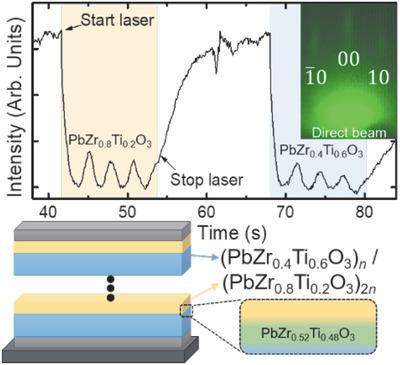当前位置:
X-MOL 学术
›
Adv. Electron. Mater.
›
论文详情
Our official English website, www.x-mol.net, welcomes your feedback! (Note: you will need to create a separate account there.)
Large Polarization and Susceptibilities in Artificial Morphotropic Phase Boundary PbZr1−xTixO3 Superlattices
Advanced Electronic Materials ( IF 6.2 ) Pub Date : 2020-01-22 , DOI: 10.1002/aelm.201901395 Eduardo Lupi 1 , Anirban Ghosh 1 , Sahar Saremi 1, 2 , Shang‐Lin Hsu 2 , Shishir Pandya 1 , Gabriel Velarde 1 , Abel Fernandez 1 , Ramamoorthy Ramesh 1, 2 , Lane W. Martin 1, 2
Advanced Electronic Materials ( IF 6.2 ) Pub Date : 2020-01-22 , DOI: 10.1002/aelm.201901395 Eduardo Lupi 1 , Anirban Ghosh 1 , Sahar Saremi 1, 2 , Shang‐Lin Hsu 2 , Shishir Pandya 1 , Gabriel Velarde 1 , Abel Fernandez 1 , Ramamoorthy Ramesh 1, 2 , Lane W. Martin 1, 2
Affiliation

|
The ability to produce atomically precise, artificial oxide heterostructures allows for the possibility of producing exotic phases and enhanced susceptibilities not found in parent materials. Typical ferroelectric materials either exhibit large saturation polarization away from a phase boundary or large dielectric susceptibility near a phase boundary. Both large ferroelectric polarization and dielectric permittivity are attained wherein fully epitaxial (PbZr0.8Ti0.2O3)n/(PbZr0.4Ti0.6O3)2n (n = 2, 4, 6, 8, 16 unit cells) superlattices are produced such that the overall film chemistry is at the morphotropic phase boundary, but constitutive layers are not. Long‐ (n ≥ 6) and short‐period (n = 2) superlattices reveal large ferroelectric saturation polarization (Ps = 64 µC cm−2) and small dielectric permittivity (εr ≈ 400 at 10 kHz). Intermediate‐period (n = 4) superlattices, however, exhibit both large ferroelectric saturation polarization (Ps = 64 µC cm−2) and dielectric permittivity (εr = 776 at 10 kHz). First‐order reversal curve analysis reveals the presence of switching distributions for each parent layer and a third, interfacial layer wherein superlattice periodicity modulates the volume fraction of each switching distribution and thus the overall material response. This reveals that deterministic creation of artificial superlattices is an effective pathway for designing materials with enhanced responses to applied bias.
中文翻译:

人工形态相边界PbZr1-xTixO3超晶格中的大极化和磁化率
产生原子上精确的人造氧化物异质结构的能力允许产生异质相和增强母体材料中未发现的磁化率的可能性。典型的铁电材料或者在远离相边界处表现出大的饱和极化,或者在相边界附近表现出大的电介质敏感性。铁磁极化率和介电常数均大,其中完全外延(PbZr 0.8 Ti 0.2 O 3)n /(PbZr 0.4 Ti 0.6 O 3)2 n(n产生2个,4个,6个,8个,16个单位晶格的超晶格,使得整个薄膜化学处于同相相界,而本构层则不在。长(Ñ ≥6)和短周期(Ñ = 2)超晶格揭示大的铁电饱和极化(P小号= 64μC厘米-2)和小的介电电容率(ε - [R ≈400在10kHz)。但是,中间周期(n = 4)的超晶格同时表现出较大的铁电饱和极化(P s = 64 µC cm -2)和介电常数(εr= 10 kHz时为776)。一阶反转曲线分析揭示了每个母层和第三界面层的开关分布,其中超晶格周期性会调节每个开关分布的体积分数,从而调节总体材料响应。这表明确定性地创建人工超晶格是设计对施加的偏斜响应增强的材料的有效途径。
更新日期:2020-03-09
中文翻译:

人工形态相边界PbZr1-xTixO3超晶格中的大极化和磁化率
产生原子上精确的人造氧化物异质结构的能力允许产生异质相和增强母体材料中未发现的磁化率的可能性。典型的铁电材料或者在远离相边界处表现出大的饱和极化,或者在相边界附近表现出大的电介质敏感性。铁磁极化率和介电常数均大,其中完全外延(PbZr 0.8 Ti 0.2 O 3)n /(PbZr 0.4 Ti 0.6 O 3)2 n(n产生2个,4个,6个,8个,16个单位晶格的超晶格,使得整个薄膜化学处于同相相界,而本构层则不在。长(Ñ ≥6)和短周期(Ñ = 2)超晶格揭示大的铁电饱和极化(P小号= 64μC厘米-2)和小的介电电容率(ε - [R ≈400在10kHz)。但是,中间周期(n = 4)的超晶格同时表现出较大的铁电饱和极化(P s = 64 µC cm -2)和介电常数(εr= 10 kHz时为776)。一阶反转曲线分析揭示了每个母层和第三界面层的开关分布,其中超晶格周期性会调节每个开关分布的体积分数,从而调节总体材料响应。这表明确定性地创建人工超晶格是设计对施加的偏斜响应增强的材料的有效途径。



























 京公网安备 11010802027423号
京公网安备 11010802027423号